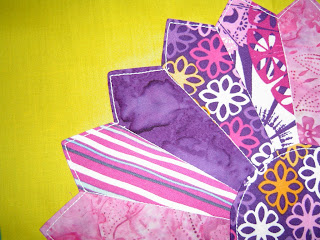I haven't been sitting at my sewing machine all that much lately. I do have a few projects lined up but finding it difficult to carve out the time to put other things aside to concentrate on making much progress. Not to mention that my fabric cutting table has also become the homework, craft & model making table. So this week I decided I'd (literally) sweep away everyone's crayons, worksheets and pumpkins full of Halloween candy to create a one block project as a practice and to try a new design or technique. Call it my 'Block Of The Week'.
This one is in preparation for a quilt project I have in the planning stage. Sticking with a traditional quilt for this one, so not much creative designing to do, just fabric selections and prep at this point. The design is a very old and traditional block called a Dresden or a Dresden Plate. I've been wanting to plan a Dresden Plate quilt project for a long time. I tend to like the designs that have an interesting history or that just look old fashioned. I also like the look of reproduction or vintage look-a-like fabrics. Those types of fabrics work well with this design, as in the Double Wedding Ring design. Like the double wedding ring, this quilt pattern is another from the depression era of quilting, possibly earlier but it is a great example of a popular depression design. The reason for that is due to the fact that many small cuts of fabric are needed, so for a time when large bolts or yardage of fabrics are hard to come by quilters would use scraps of fabrics that are easy to obtain... old pieces of clothing, cotton dress fabric, etc.
The Dresden Plate block is characterized by a flower-like design of wedge shaped pieces of fabric fashioned in a circle resembling petals of a flower. There are a few variations on the shapes of the petals as they can be cut straight across, in an arch or in a point, as I have done here.
This Dresden is a sample, so the fabrics are somewhat obnoxious and the thread used would not normally be white.. as you can see it sticks out like double trimmed seam of a 1970s leisure suit.
Some quilters choose to use a nylon mono-filament thread for the top quilting of the petals here as it is clear and would be the best way to hide the quilting. In this case I was not so much concerned about that as I had only two objectives; (1) create my first Dresden block to practice for the next quilt on my table and (2) try out the new "Easy Dresden" ruler that I bought for the project.
This ruler is an awesome product and I highly recommend it! I'm sure that there are some who think that using the ruler template for the fabric cuts is cheating... well those hard core quilters can be my guest and sit at their cutting tables painstakingly cutting 20 petals X 24 plates in perfect 16 degree angles. If I were using those hand cutting, and hand quilting methods I would never see a project completed. I'm very much someone who needs to see regular progress to remain motivated. Time savers like this ruler are great ways for busy people to continue to enjoy these types of hobbies.
One major reason I like this ruler is the technique that they recommend for making the points at the top of the petals. Another ruler I purchased was more of a template that had a point on it that you cut and then to make the edges finished you folded over your 1/4 inch seam allowance. This method recommends you cut the wedge, the same shape of the ruler, then fold in half longways, with right sides together and sew straight across your 1/4 seam allowance. When you then turn the seam back and press you have a finished edge. This photo shows the back side of the point that is created as a result of this step.
Another interesting tip that makes this pattern easier is the time saver offered for the circle in the center of the petals. The suggested method here is to cut a circle the size of the middle fabric, cutting your fabric slightly larger. Then string a running stitch around the edge of the fabric and draw it up around the cardboard circle and press. Cardboard works well here as it will withstand the heat of the iron, but my error was not using thin enough cardboard. I used cardboard from the bottom of a Poland Springs case of water, not exactly corrugated cardboard but still think and sturdy. The fault I found with that was that the circle was kinda sloppy. You can see in the finished photo of the block that it isn't quite round. I think that cardboard from maybe a cereal box might work better.
This is a real fun block to create and somewhat fast to build. Once fabrics are selected and cut, I'd say this is a one week or even a weekend quilt project, at least quilt top completion. Be on the lookout for a quilt project with this block from my quilt table within the next month or two. Next week I think I'll do a few stars for my block of the week getting ready for Christmas.
Welcome to my blog. I'll be offering topics for discussion or just what happens to be on my mind. Most of all I built this blog as a place to discuss my hobby of quilting. So, if you have found this blog and are interested in the same, welcome. Some days I'll be sitchin and will post topics related to current quilt projects, fabric I've found, patterns and quilting techniques. On other days, well.. as the name implies.. Thanks for visiting, Kim Girolamo-Vogler






